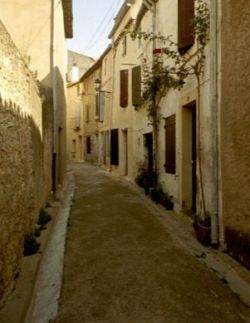|
|
|
 |
PUISSERGUIER (Puècherguier) |
|
|||
 |
|
||||
|
Puisserguier |
Office de Tourisme
|
||||
|
Puisserguier is a typical southern French wine village. It lies close to the Mediterranean Sea. Beziers, the largest nearby town is 16 kms away. The spanish border at Le Perthuis is 128 kms away. Puisserguier has a history that goes back to medieval times and belongs to a type of village called the circulades This kind of architecture dates from the Romanesque period where the streets are built in concentric circles around the base of the chateau. As early as 1146 Puisserguier was known as Podium Serigarium, and then later became Puecherguier.
|
 the streets are built in concentric circles |
||||
|
|
The Chateau dates from the 11th Century and still brings back memories of Simon de Montfort and the Cathar Wars in 1209. Many remains of the original walls of Puisserguier can be found around the village.
|
||||
|
In the Rue Parmentier and the Impasse Lapeyronie you will find signs of old wells that served the village. These wells connected to underground passages that communicated with the castle at Maureilhan and the Priory at St Christophe, just outside the village. |
 an old village well |
||||
|
|
The Church of St Paul dates from the 14th Century and contains an organ that reaches its 100 hundredth year in 2000. Just outside the village in the direction of Cazedarnes lies the Priory of St Christophe dating from the 17th Century. Lost in the Pinewoods it is now only used once a year. It was thought by the villagers that St Christophe protected them, and their vineyards, that are so important to the economy of Puisserguier. It is said that Saint Clementine came to Puisserguier after discovering the small oranges in north Africa, and one of the roads in the village bears his name. | ||||
|
The Town Hall or Marie is housed, in what was an imposing family mansion. Many houses are reminders of the wealth of the village in times gone bye. Puisserguier sat on one of the many pilgrim routes that crossed France to the Cathedral of St Jacques du Campostelle in northwestern Spain. In the Rue de la Coquille it is possible to see, set in the wall of one of the houses, a shell sculptured in stone. It was normal for the pilgrims to mark their route in this manner, but few of these symbols survive. Puisserguier is typical of many of the wine villages of the Herault, and time should be set aside for exploring on foot. Many surprises await you, and if you make the effort to speak to the locals you will be made very welcome. A typical market takes place every Friday during the morning. |
 The Town Hall or Marie |
||||
|
|
The National Institute of Preventative Archaeological Research INRAP, has
recently performed a lot of work in Puisserguier, when,as a result of some
excavation work for a new development in the village, an Iron Age (9th to
the 7th century B.C.) cemetery was revealed. Unusually the cemetery
was intact and contained 235 graves. The burials sites took the form of a
circular pit into which the urn containing the ashes of the deceased person
had been placed.It was then covered over by a heavy circular stone. The heart of the cemetery contained two tombs of special interest; these were more complex, perhaps indicating that the people were of a higher status. It was the exclusive practice to cremate adults in
the
|
||||
|
|
For more information on the Region |
||||
| AddMe.com, |
|
||||